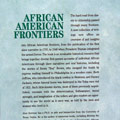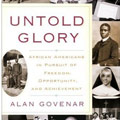African American Frontiers: Slave Narratives and Oral Histories
by Alan Govenar
About
Published: Santa Barbara, California and Oxford, England: ABC-CLIO, 2000
Details: Library Binding; 551 pages
Format: 1.47 x 10.35 x 7.33 in.
Reviews
From Booklist
When studying the experiences of people caught up in the Americas' slave trade, researchers have traditionally focused on the human and social conditions as set down in the slaves' personal narratives or on the literary genre that developed from the documentation of their experiences. Approaching this large collection of historical material from a different perspective, Govenar "explores the frontier as both place and idea, specifically as it relates to African Americans." As he points out in the introduction to this volume, for the indentured servants and slaves transported from Africa to the New World, "the possibility of freedom represented the first frontier."
The informative introduction provides a historical overview of the origins, practice, and progress of slavery in the Americas. Geographical frontiers surface in the details concerning the movement of slaves across the states. Maps giving the percentages of slaves and numbers of freed blacks in the population, state by state, over a 200-year period beginning with the late 1700s, provide not only a source of relevant statistics but also a visual time line. The social, economic, and cultural frontiers that developed as runaway and freed slaves migrated west and north seeking opportunities for a new life emerge in the accounts of their life experiences. These accounts are contained in two narrative sections following the introduction. The first section is composed of 15 significant slave narratives, including those of William and Ellen Craft, Olaudah Equinao, and Harriet Tubman. Most of these narratives have been published elsewhere in collections such as The Civitas Anthology of African Slave Narratives (1999), which examines slave narratives as the foundation of the African American literary tradition. The second section contains seven Works Progress Administration narratives from the Federal Writers' Project of the late 1930s.
A third section contains 47 fairly extensive oral histories that Govenar either collected through interviews he conducted or edited from existing materials found in archives. These more recent accounts provide details of life experiences from the nineteenth and twentieth centuries and provide a bridge to the present day. A list of contributors of the oral histories gives the occupation or career of each person, including college president, physician, U.S. Air Force colonel, civil-rights activist, minister, cowboy, and more. They further illustrate the array of frontiers encountered and crossed by African Americans.
Each narrative or oral history begins with biographical and background details, and many include photographs or other illustrations. Two bibliographies, one of individually published slave narratives and another of secondary sources, provide further material for researchers. Public, community-college, and high-school libraries should find this reference tool a valuable addition to their collections. RBB
Copyright © American Library Association. All rights reserved
From School Library Journal
Gr 9 Up-Using carefully selected, authentic oral transcriptions, this work successfully portrays what life was like for African Americans from slavery through emancipation and into the 20th century. Govenar includes 67 life stories that illustrate the diverse experiences of the men and women who sought a new life in the expanding West or who opened social and cultural opportunities. There are tales of migration from the Caribbean to St. Louis and from Texas to Los Angeles, as well as stories of success and achievement during the Harlem Renaissance. The primary-source material includes original slave narratives, WPA slave narratives, state historical-society archive documents, and interviews conducted by the author. The histories of such well-known individuals as Frederick Douglass, Harriet Tubman, and Jacob Lawrence are included along with those of a window dresser, civil-rights worker, and rodeo cowboy. This well-organized, attractive volume has a handsome typography and high-quality, black-and-white photographs and maps.
Janet Woodward, Garfield High School, Seattle, Washington
Copyright © 2001 Cahners Business Information, Inc.
From Library Journal May 2001
"...successfully portrays what life was like for African Americans from slavery through the emancipation and into the 20th century.”


